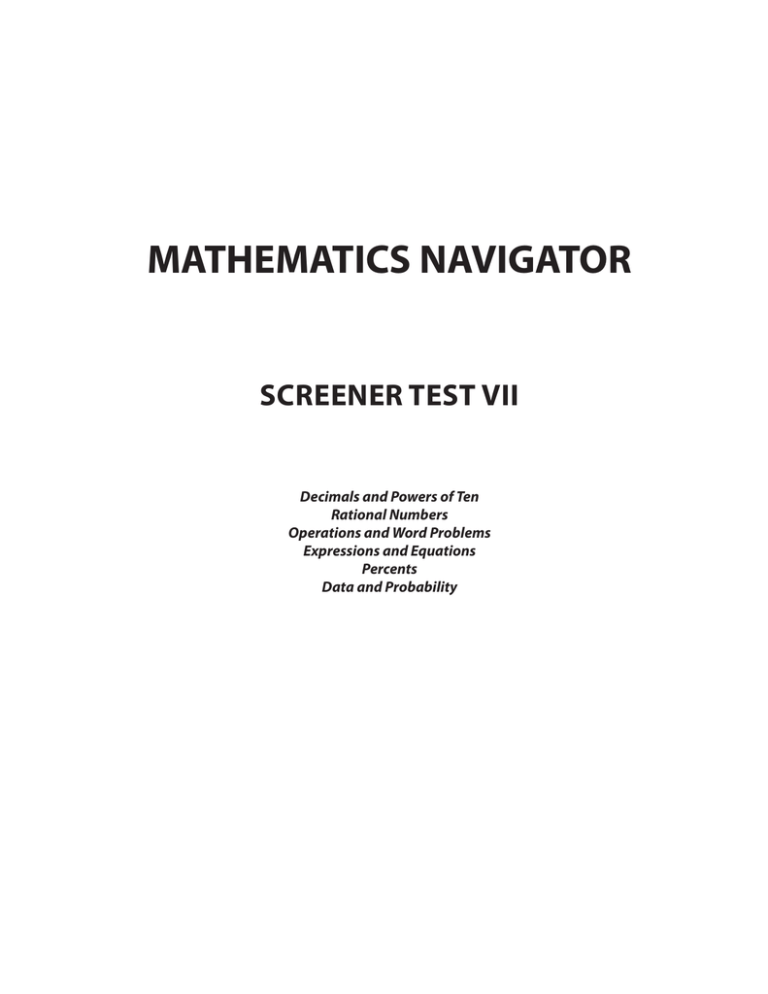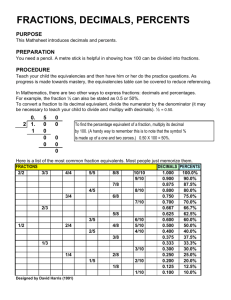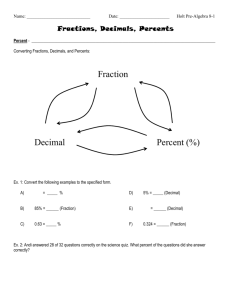
MATHEMATICS NAVIGATOR
Screener Test VII
Decimals and Powers of Ten
Rational Numbers
Operations and Word Problems
Expressions and Equations
Percents
Data and Probability
This Screener Test has been designed to correlate with the NCTM Curriculum Focal Points.
Each Screener Test focuses on three to eight Mathematics Navigator modules, which in turn
focus on addressing misconceptions students may have about mathematics concepts.
Screener Test VII is designed to be given at the beginning of the school year. It covers the
standards that students need in order to be successful at their grade level.
The results of this Screener Test will help instructors identify gaps in students’ knowledge and
determine which Mathematics Navigator modules will help fill those gaps. Participation in
these modules will help students succeed in mathematics and on their state assessments tests.
America’s Choice® is a subsidiary of the National Center on Education and the Economy® (NCEE), a Washington, DC-based
non-profit organization and a leader in standards-based reform. In the late 1990s, NCEE launched the America’s Choice School
Design, a comprehensive, standards-based, school-improvement program that serves students through partnerships with states,
school districts, and schools nationwide. In addition to the school design, America’s Choice provides instructional systems in
literacy, mathematics, and school leadership. Consulting services are available to help school leaders build strategies for raising
student performance on a large scale.
© 2009 by America’s Choice
All rights reserved. No part of this publication may be reproduced or transmitted in any form or by any means, electronic or
mechanical, including photocopy, recording, or any information storage and retrieval system without permission from the
America’s Choice permissions department.
America’s Choice and the America’s Choice logo are registered trademarks of America’s Choice. The National Center on
Education and the Economy is a registered trademark of The National Center on Education and the Economy.
First Printing 2009
1 2 3 4 5 6 7 8 9 10 12 11 10 09 08
ISBN 978-1-60637-606-5
http://www.americaschoice.org
e-mail: products@americaschoice.org
Screener Test VII
1. Find the difference.
8.43
– 5.02
4. When Jan was 10 years old he was
1.35 meters tall. One year later, he was
0.1 meter taller.
How tall was Jan when he was 11
years old?
A.
3.40
B.
3.41
A.
1.36 meters tall
C.
4.31
B.
1.45 meters tall
D
4.01
C.
2.35 meters tall
D.
1.46 meters tall
–––––––––––––––––––––––––––––––––––––––––
2. Ryan finished a race in 11.34 seconds.
Tom finished 0.1 second later. What
was Tom’s time?
A.
11.35 seconds
B.
11.44 seconds
C.
12.34 seconds
D.
11.33 seconds
–––––––––––––––––––––––––––––––––––––––––
3. Find the difference.
6 – 4.32 =
A.
1.58
B.
1.68
C.
2.58
D.
2.68
–––––––––––––––––––––––––––––––––––––––––
5. Find the sum.
3.75 + 15.264 =
A.
15.639
B.
18.914
C.
19.014
D.
20.014
–––––––––––––––––––––––––––––––––––––––––
6. What number do you get if you
subtract one-tenth from 11?
A.
10.01
B.
10
C.
1
D.
10.9
➥
GO ON
©America’s Choice
Mathematics Navigator
|
Screener Test VII
7.
2
=
5
9. What fraction of this square is white?
?
A.
2
10
B.
4
10
C.
5
10
D.
4
5
–––––––––––––––––––––––––––––––––––––––––
8. Which symbol would you use to
compare this fraction and decimal?
2
? 0.123
13
A.
=
B.
<
C.
>
D.
≤
A.
8
5
B.
5
8
C.
2
3
D.
3
5
–––––––––––––––––––––––––––––––––––––––––
10. 2
1
3
3
+ –1
=
2
5
10
A.
1
4
5
B.
1
1
10
C.
1
1
3
D.
1
7
10
➥
GO ON
|
Screener Test VII
©America’s Choice
Screener Test VII
11. John and Valerie were late returning a
book from the library and had to pay
1
overdue fines. John had of the
5
2
money they owed. Valerie had of
3
the money they owed.
Together, what fraction of the money
owed did they have?
A.
3
8
B.
2
15
C.
13
15
D.
2
8
13. A box containing 30 blank DVDs has
a price tag of $44.10. How much is
each DVD?
A.
$0.68
B.
$1.11
C.
$1.47
D.
$14.70
–––––––––––––––––––––––––––––––––––––––––
14. Which word problem goes with
this calculation?
6.75 × 4.84 = 32.67
A.
Joe paid $6.75 for gas. The gas
costs $4.84 per gallon. How
many gallons did he buy?
B.
Joe has a garden that has an
area of 6.75 square meters. It
is 4.84 meters long. How wide
is it?
C.
Joe bought 6.75 meters of fabric
at $4.84 per meter. How much
does the fabric cost?
D.
Joe bought a bag of carrots
that was priced at $6.75 and
reduced to $4.84 in a sale. How
much did Joe save?
–––––––––––––––––––––––––––––––––––––––––
12.
2
1
1
×1
÷
=
3
12
3
A.
5
B.
6
13
C.
3
D.
2
1
6
➥
GO ON
©America’s Choice
Mathematics Navigator
|
Screener Test VII
15. Suppose 3 dozen cans of tomato paste
cost $5.76. What is the cost of 2 cans?
A.
$0.16
B.
$0.32
C.
$0.96
D.
$3.84
18. If a truck can move 8,775 pounds of
dirt in one trip, how much dirt can it
move in 225 trips?
A.
9,000 pounds
B.
39 pounds
C.
393,875 pounds
D.
1,974,375 pounds
–––––––––––––––––––––––––––––––––––––––––
1
-cup portions can you
4
4
get from a can that contains of
5
a cup?
16. How many
A.
1
5
B.
3
C.
3
D.
1
4
5
–––––––––––––––––––––––––––––––––––––––––
19. Which expression shows the cost of
renting a bicycle at $1.50 per hour for
x hours?
A.
x + 1.5 dollars
1
5
B.
x
dollars
1.5
4
5
C.
15x dollars
D.
1.5x dollars
–––––––––––––––––––––––––––––––––––––––––
17. Jin drove for one and one-half hours
at 65 miles per hour. How far did
she drive?
–––––––––––––––––––––––––––––––––––––––––
20. Write an algebraic expression for the
following instructions. The letter x
stands for “any number.”
Multiply x by 4, then square
your answer.
A.
32.5 miles
A.
16x2
B.
43.3 miles
B.
x • 42
C.
65 miles
C.
8x2
D.
97.5 miles
D.
16x
➥
GO ON
|
Screener Test VII
©America’s Choice
Screener Test VII
21. Find the expression that goes with
this table.
x
4
6
9
0
14
Answers
22
34
52
–2
82
A.
6x – 2
B.
6(x – 2)
C.
6(x + 2)
D.
2(x + 6)
–––––––––––––––––––––––––––––––––––––––––
22. Solve.
x
2
2–
=
5
3
23. Pablo’s summer job paid him $7.80 an
hour and 50% more for overtime. In
June, his overtime pay was $286.65.
If x represents the number of hours
he worked overtime, which equation
could be used for calculating x?
A.
1.5 + 7.8x = 286.65
B.
7.8 + 0.5x = 286.65
C.
1.5 • 7.8x = 286.65
D.
(0.5 + 7.8)x = 286.65
–––––––––––––––––––––––––––––––––––––––––
24. Is this equation always true, never
true, sometimes true, or you can’t tell?
3(x + 5) = 3x + 15
A.
x = –6
2
3
B.
x = 10
2
3
C.
3
x=
20
D.
x=6
A.
Always true
B.
Never true
C.
Sometimes true
D.
Can’t tell
2
3
➥
GO ON
©America’s Choice
Mathematics Navigator
|
Screener Test VII
25. Write
7
as a percent.
10
27. Jong ordered chicken to be delivered.
The bill was $7.77. He paid $9.00.
What percent tip did he give? Round
to the nearest percent.
A.
70%
B.
7%
A.
1%
C.
0.7%
B.
16%
D.
0.07%
C.
30%
D.
14%
–––––––––––––––––––––––––––––––––––––––––
26. For this problem, refer to the following
sale sign from a clothing store:
Summer Sale!
Swimsuits
T-shirts
Ties
Shorts
Coats
were $35,
now reduced by 25%
were $20,
now reduced by 15%
were $24,
now reduced by 40%
were $31,
now reduced by 10%
were $72,
now reduced by 30%
–––––––––––––––––––––––––––––––––––––––––
28. Jin bought some roses for her friend.
She had 15 red roses and 5 white roses.
What percent were white roses?
A.
25%
B.
33%
C.
20%
D.
400%
How much would you pay if you
bought a swimsuit and a coat?
A.
$76.65
B.
$30.35
C.
$77.57
D.
$107.00
➥
GO ON
|
Screener Test VII
©America’s Choice
Screener Test VII
29. Mario saw a jacket that was priced at
$80. Then, the price was reduced
by 25%.
What decimal multiplier should you
use to find the new price?
A.
1.25
B.
0.25
C.
0.75
D.
1.75
–––––––––––––––––––––––––––––––––––––––––
30. Mary correctly answered 27 out of 40
problems on an English test, 13 out of
20 on a history test, and 42 out of 60
on an algebra test. Which subject did
she do best in?
31. Daniel and Greta are playing a word
game. They have played 30 games.
Daniel has won 6 times and Greta has
won 24 times. Based on these results,
what is the probability that Daniel will
win the next game?
A.
0.2
B.
5
C.
0.25
D.
6
–––––––––––––––––––––––––––––––––––––––––
32. A spinner has 5 sections. Below are
the results from spinning the spinner
200 times.
Section
Frequency
A.
English
1
10
B.
Algebra
2
50
C.
History
3
40
D.
Cannot compare
4
50
5
50
Based on these results, if a spinner
is spun 100 times, about how many
times will it land on section 1?
A.
10
B.
20
C.
5
D.
You cannot predict; the sample
is too small.
➥
GO ON
©America’s Choice
Mathematics Navigator
|
Screener Test VII
33. A survey was taken showing the number of brothers and sisters 30 students have.
This table shows the data with the frequency of responses.
Siblings
1
2
3
4
6
Frequency
10
6
3
8
3
What is the mode of this data set?
A.
1
B.
2
C.
2.5
D.
2.7
–––––––––––––––––––––––––––––––––––––––––––––––––––––––––––––––––––––––––––––––––––––
34. This graph shows the annual salaries of graduates from a small college.
Annual Salaries (dollars)
25,000 35,000 45,000 55,000 65,000
What is the approximate median salary?
A.
39,500
B.
40,000
C.
45,000
D.
35,000
➥
GO ON
|
Screener Test VII
©America’s Choice
Screener Test VII
35. The table below shows the number of students who are involved with musical
instruments at Middleview High School.
10th Grade
11th Grade
12th Grade
Jazz Band
4
8
12
School Band
28
46
20
Marching Band
22
30
25
Orchestra
20
32
27
Which graph best represents this data set?
Jazz Band
School
Band
B.
Orchestra
Marching
Band
C.
Students Enrolled
80
60
40
20
0
Jazz
Band
School Marching Orchestra
Band
Band
D.
30
25
School
Band
20
15
10
Jazz
Band
Marching Orchestra
Band
5
0
100
Students Enrolled
A.
Jazz
Band
School Marching Orchestra
Band
Band
➥
GO ON
©America’s Choice
Mathematics Navigator
|
Screener Test VII
36. Jerry worked at odd jobs during the summer and kept a log of his daily earnings.
He earned the following amounts:
0
1
2
3
4
889
0223345555778
005
4
What is the mean of his daily earnings?
A.
16
B.
15
C.
1.75
D.
4.50
STOP!
10
|
Screener Test VII
©America’s Choice
Screener Test VII Answer Key
Question Answer
Number
Key
Content Description
Unit
B
Applies an understanding of decimal models,
place value, and number properties to subtract
two decimals
2
B
Applies an understanding of decimal models, place
value, and number properties to add two decimals in
the context of a word problem
3
B
Applies an understanding of decimal models, place
value, and number properties to subtract a decimal
from a whole number
4
B
Applies an understanding of decimal models, place
value, and number properties to add decimals in the
context of a word problem involving measurement
5
C
Applies an understanding of decimal models, place
value, and number properties to add two decimals
6
D
Applies an understanding of decimal models, place
value, and number properties in order to subtract a
fraction given in words from a whole number
7
B
Uses a knowledge of the meanings of fractions and
properties of operations to find equivalent fractions
8
C
Applies knowledge of converting fractions to
decimals to compare and order a fraction and a
decimal using an inequality symbol
9
B
Applies an understanding of fractions, area models,
and “part versus whole” to determine what fraction
of a figure is not shaded
1
A
Applies an understanding of fractions and
fraction models to add and subtract fractions
with unlike denominators
11
C
Applies an understanding of fractions and
fraction models to add and subtract fractions with
unlike denominators in the context of a word problem
12
D
Uses a knowledge of the rules for multiplying and
dividing fractions to solve a two-step problem
10
©America’s Choice
Decimals and
Powers of Ten
Rational
Numbers
Mathematics Navigator
|
11
Screener Test VII Answer Key
Question Answer
Number
Key
Content Description
C
Uses simple reasoning about multiplication and
division to solve one-step word problems involving
ratio and rate
14
C
Uses simple reasoning about multiplication and
division to select a word problem that illustrates a
multiplication problem involving decimals
15
B
Uses simple reasoning about multiplication and
division to solve multistep word problems involving
ratio and rate
B
Builds on a knowledge of fractions to solve a word
problem that involves finding the fractional part of a
fractional whole
D
Uses simple reasoning about multiplication and
division to solve one-step word problems involving
ratio and rate
D
Uses simple reasoning about multiplication and
division to solve one-step word problems involving
ratio and rate, as well as multiplication of three- and
four-digit numbers
19
D
Uses simple reasoning about multiplication to write
an expression that could be used to solve a word
problem involving rate
20
A
Identifies an algebraic expression based on a
verbal description
21
A
Describes simple relationships by selecting an
expression that matches a given table
D
Understands that variables represent numbers whose
exact values are not yet specified and uses knowledge
of the arithmetic of rational numbers to solve linear
equations in one variable
C
Understands that variables represent numbers whose
exact values are not yet specified and uses knowledge
of the arithmetic of rational numbers to write an
equation that represents a word problem
A
Uses the commutative, associative, and distributive
properties to determine whether an equation is
always true, never true, or sometimes true
13
16
17
18
22
23
24
12
|
Screener Test VII
Unit
Operations and
Word Problems
Expressions
and Equations
©America’s Choice
Screener Test VII Answer Key
Question Answer
Number
Key
Content Description
Unit
A
Uses division and an understanding of fractions and
decimals to express a fraction as a percent
A
Develops an understanding of percents in
everyday situations by solving a multistep word
problem involving percent discounts Develops an
understanding of percents in everyday situations by
solving a multistep word problem involving tips
27
B
Develops an understanding of percents in everyday
situations by solving a multistep word problem
involving tips
28
A
Uses division and an understanding of fractions and
decimals to determine the percent in a word problem
29
C
Develops an understanding of percents in everyday
situations by solving a word problem involving
percent discounts
30
B
Uses division and an understanding of fractions and
decimals to determine percents in a word problem
and use the information to solve the problem
31
A
Applies an understanding of the concept that when
all outcomes of an experiment are equally likely,
the theoretical probability of an event is the fraction
of outcomes in which the event occurs to find
a probability
32
C
Applies an understanding of proportions to make
predictions based on data in a table
A
Uses descriptive statistics, including mean,
median, mode, and range, to describe data
represented in a table
34
A
Uses descriptive statistics, including mean,
median, and range, to describe data represented
in a box and whisker plot
35
B
Analyzes different bar graphs and pie charts in order
to determine which graph best represents the data
in a table
A
Uses descriptive statistics, including mean,
median, and range, to describe data represented
in a stem-and-leaf plot
25
26
33
36
©America’s Choice
Percents
Data and
Probability
Mathematics Navigator
|
13







